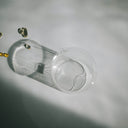Hair transplants can be a life-changing solution to hair loss—when they’re done right.
But sometimes things don’t go as planned, leaving patients frustrated or even worse off than before.
If you’re worried about a failed hair transplant or just want to avoid one, this article is here to help.
We'll cover what can go wrong, why it happens, and how to fix or prevent it—all in plain, friendly language.
Table of content
Can a hair transplant go wrong?
Yes, a hair transplant can go wrong if performed by inexperienced surgeons, at unlicensed clinics, or without proper planning. Common issues include unnatural hairlines, scarring, infections, or poor hair growth.
Fortunately, most problems are preventable or fixable with the right approach and expertise.
As your leading source for hair health information over the past 4 years, we never compromise on accuracy. When it comes to your health, you deserve information you can truly rely on - and earning your trust is our top priority.
Here's how Scandinavian Biolabs ensures every piece of content meets the highest standards of accuracy and integrity:
- Credentialed Experts: Our reviewers are actively practicing doctors and medical researchers
- Stringent Reviews: Content undergoes rigorous editing by subject specialists and review by a practicing doctor.
- Evidence-Based: We rely on well-established research from trusted scientific sources like peer-reviewed journals and health authorities.
- Full Transparency: Our editorial standards, writer credentials, reviewer credentials, correction process, and funding are all publicly documented.
- Independent Voice: While we do promote products, we operate in a vacuum to business operations. Our main goal is just an unwavering commitment to providing medically-sound guidance.
You can count on Scandinavian Biolabs to consistently deliver the trustworthy health information you deserve. Read our Editorial Standards.
What can go wrong with a hair transplant?
Hair transplants are considered safe, but like any surgery, complications can happen. When things go wrong, it can lead to physical or aesthetic issues that might require further treatment.
Here are some of the most common things that can go wrong:
- Unnatural hairlines that don’t match your facial structure.
- Visible scarring in the donor or recipient area.
- Infections that cause redness, swelling, or even abscesses.
- Hair follicles failing to take root, leading to patchy or poor hair growth.
- Tissue necrosis, where skin dies due to interrupted blood flow.
When done by a skilled professional, these risks are rare. But understanding what could happen is the first step to avoiding trouble.
Common causes of a failed hair transplant
Hair transplants fail for various reasons, often tied to poor execution or aftercare. Here are some common culprits:
Poor planning and hairline design
A successful hair transplant starts with a carefully designed plan. This includes deciding where the hairline will go and how many grafts are needed.
Unskilled surgeons may create hairlines that are too high, too low, or unnatural-looking, leaving patients disappointed.
Inexperienced or unqualified surgeons
Some clinics employ staff without proper medical training to save costs. Unqualified surgeons often make errors during graft extraction or implantation, leading to scarring, uneven density, or damaged follicles.
Always check your surgeon’s credentials and experience.
Overharvesting from the donor area
Taking too many grafts from one area can cause visible bald spots or patchiness in the donor zone. This problem can make future transplants difficult or impossible.
Substandard hygiene or equipment
Infections often stem from unclean tools or poorly sterilized environments. Clinics that cut corners on hygiene can put patients at serious risk of infections, scarring, or even sepsis.
Inadequate aftercare
Even a perfectly executed transplant can fail without proper aftercare. Ignoring post-op instructions, like avoiding sun exposure or smoking, can damage the grafts and impact results.
Warning signs of a botched hair transplant
Sometimes, the results of a bad transplant are obvious. Other times, the signs are more subtle but still worth noting.
Here are some red flags to watch for:
- An unnatural or uneven hairline.
- Persistent redness, swelling, or signs of infection.
- Visible scarring in the donor or recipient areas.
- Sparse, patchy, or uneven hair growth.
- Cysts or bumps forming in the transplanted area.
- Darkened or dead tissue, which may indicate necrosis.
If you spot any of these issues, it’s important to consult a specialist right away.
Examples of hair transplant gone wrong
While most hair transplants are successful, not every story has a happy ending. Poor planning, unqualified surgeons, and unsafe clinics can leave patients facing complications that require expensive corrective measures. Here’s a look at two common scenarios:
Turkey hair transplants gone wrong
Turkey has become a hotspot for affordable hair transplants, attracting thousands of patients each year. While some clinics offer excellent care, many operate without proper licensing or trained professionals.
A common issue in Turkey’s budget clinics is overharvesting, where too many hair follicles are taken from the donor area, leaving it patchy and scarred.
Some patients have reported being operated on by unqualified staff, including non-medical personnel.
For example, one patient was promised 5,000 grafts without anyone evaluating his scalp. The result? A painful, uneven transplant performed with minimal anesthesia.
Another example involved a patient who developed severe folliculitis after a beard transplant. Without proper care, the infection led to permanent scarring and patchy growth.
The low initial cost often results in higher expenses for corrective surgeries later.
Celebrity hair transplants gone wrong
Even celebrities aren’t immune to hair transplant failures. Take Wayne Rooney, for instance. His first transplant filled in thinning areas, but ongoing hair loss required multiple additional procedures.
While Rooney could afford repeated surgeries, this isn’t a viable option for everyone.
The issue often lies in unrealistic expectations. A transplant can restore hair to bald areas, but it doesn’t stop natural hair loss. Maintenance treatments like Minoxidil or Finasteride are needed to sustain results.
Celebrities with unlimited budgets can afford regular upkeep, but for the average person, these ongoing costs can add up quickly.
The most common hair transplant problems
Hair transplants are generally safe, but when things go wrong, the results can be frustrating and disheartening. Below are some of the most frequent issues patients encounter:
Excessive harvesting from the donor area

Skilled surgeons know how to balance the number of grafts taken with the condition of the donor site. Overharvesting happens when too many follicles are removed, leaving the back of the scalp looking thin or patchy.
This can also lead to unnecessary pain and scarring. Worse, it limits your options for future procedures if you need touch-ups. Clinics that cut corners or rush through surgeries are often the culprits behind this issue.
Unnecessary or significant scarring
Scarring can happen in both the donor and recipient areas, especially if outdated techniques are used. FUT (Follicular Unit Transplantation), for example, often leaves a linear scar, while poorly executed FUE (Follicular Unit Extraction) can create patchy spots.
Visible scars can make it hard to feel confident about your results.
The best surgeons use modern tools and precise methods to minimize scarring, but inexperienced providers may not have the skills to do so.
Skin or hair infections

Poor hygiene practices can lead to infections in the scalp or hair follicles. Symptoms like redness, itching, or pus-filled abscesses are signs something isn’t right.
In rare cases, untreated infections can escalate to life-threatening conditions like sepsis. This is why choosing a clinic with high standards for cleanliness and care is critical.
Necrosis and tissue damage
Necrosis occurs when the skin tissue dies due to a lack of blood flow, often caused by infections or improper surgical techniques. This condition can result in permanent scarring or even deformities in the transplant area.
Avoiding this requires choosing a skilled surgeon who prioritizes patient safety and uses modern surgical methods to reduce risks.
Hair transplant failure and poor hair growth
When grafts aren’t handled carefully, they can fail to take root, resulting in sparse or uneven hair growth. This is often due to inexperienced surgeons who don’t follow proper techniques during implantation.
Unnatural hair transplant results
Poor transplant techniques can leave patients with unnatural-looking results that draw more attention to their hair loss than before. This can include oddly shaped hairlines, uneven hair density, or hair growing in the wrong direction.
Unnatural results often stem from poor planning or lack of expertise during the grafting process. A skilled surgeon considers the natural growth patterns of your hair and tailors the transplant to match your facial structure for a seamless look.
Outdated hair transplant techniques
Modern clinics use advanced methods like FUT and FUE, which have excellent success rates and minimal scarring when performed properly. However, some clinics still rely on outdated techniques such as hair plugs.
Hair plugs involve transplanting large clumps of follicles, often resulting in an unnatural “doll’s hair” effect. This method can also cause significant trauma to the donor area, increasing the risk of infection and scarring.
The difference between modern methods and outdated techniques can often mean the difference between a confident smile and years of regret.
How to prevent hair transplant failures
Preventing hair transplant failures starts with informed decisions. Here are some steps you can take:
Research the clinic and surgeon
Don’t just settle for the first clinic you find. Look for reviews, check qualifications, and ask to see before-and-after photos from previous patients.
Clinics with board-certified surgeons and strong reputations are safer bets.
Avoid clinics offering unrealistic promises
If a clinic guarantees thousands of grafts in a single session or rock-bottom prices, that’s a red flag. High-quality transplants require time, skill, and proper resources.
Unrealistic promises often lead to disappointment.
Understand the procedure
Educate yourself about FUE, FUT, or other techniques so you know what to expect. A good surgeon will explain the process, including risks, recovery, and maintenance.
What to do if your hair transplant goes wrong
If your transplant didn’t turn out as planned, don’t panic. There are steps you can take to address the situation:
- Contact the original clinic: Most reputable clinics offer follow-up services and may help correct issues.
- Get a second opinion: Visit a qualified surgeon to assess the damage and explore corrective options.
- Consider revision surgery: A skilled surgeon can fix density, scars, or hairlines through a secondary procedure.
- Try scalp micropigmentation: For non-surgical fixes, micropigmentation can create the appearance of fuller hair.
- Use hair restoration treatments: Medications like Minoxidil or Finasteride can help improve growth in problem areas.
A botched transplant isn’t the end of the road. With the right steps, you can turn things around.
A better non-invasive alternative to a hair transplant

While hair transplants can offer permanent solutions, they aren't always the right fit for everyone. For those who want to avoid surgery, there are non-invasive options that can help support healthier hair growth and reduce hair loss—without needles or downtime.
One promising alternative is the Bio-Pilixin Activation Serum.
Developed by experts using advanced stem cell technology, this serum is designed to nourish hair follicles and encourage hair growth naturally.
What makes Bio-Pilixin Activation Serum stand out?
- Clinically tested for effectiveness: Trials show 93% of users experienced reduced hair loss after 150 days.
- Drug-free and safe for daily use: Unlike medications, the serum is gentle yet effective, making it suitable for everyday routines.
- Satisfaction backed by data: Participants in the clinical trial reported noticeable improvements in density and less hair shedding, with results often starting as early as 45 days.
What’s the evidence?
Bio-Pilixin’s effectiveness is backed by clinical testing on participants aged 18–65 with various types of hair loss.
- 77% saw reduced hair loss after just 45 days.
- 93% experienced less hair loss by day 150.
- 73% showed measurable increases in hair density over the same period.
What many users first notice is a reduction in hair shedding—fewer hairs in the shower drain or on the pillow—within weeks of starting the treatment.
What’s more reassuring is their 150-day money-back guarantee. This lets you try the product without the worry of wasting money if it doesn’t work for you.
Conclusion
Hair transplants can go wrong for several reasons, from unskilled surgeons to poor planning or aftercare. If you’re considering a transplant, do your research, find a reputable clinic, and set realistic expectations.
For those who’ve had a bad experience, corrective options like revision surgery or scalp micropigmentation can help.
But if you’re not ready to commit to surgery, the Bio-Pilixin Activation Serum offers a non-invasive, clinically tested alternative to help reduce hair loss and improve density naturally.
With many users reporting visible results in just a few weeks, it’s worth exploring.
Ready to try a gentler solution for healthier hair?
Give Bio-Pilixin Activation Serum a shot, risk-free, and see what it can do for your hair journey.
References:





